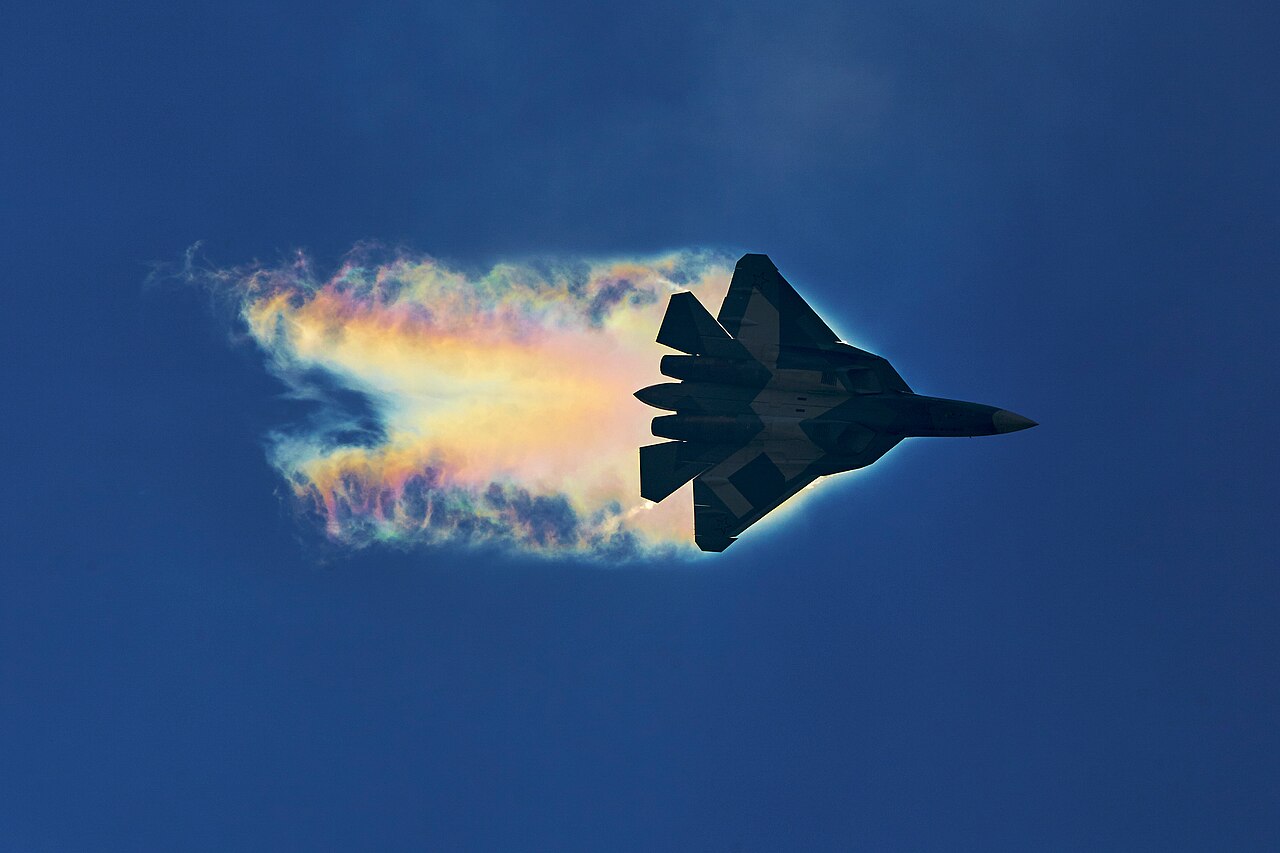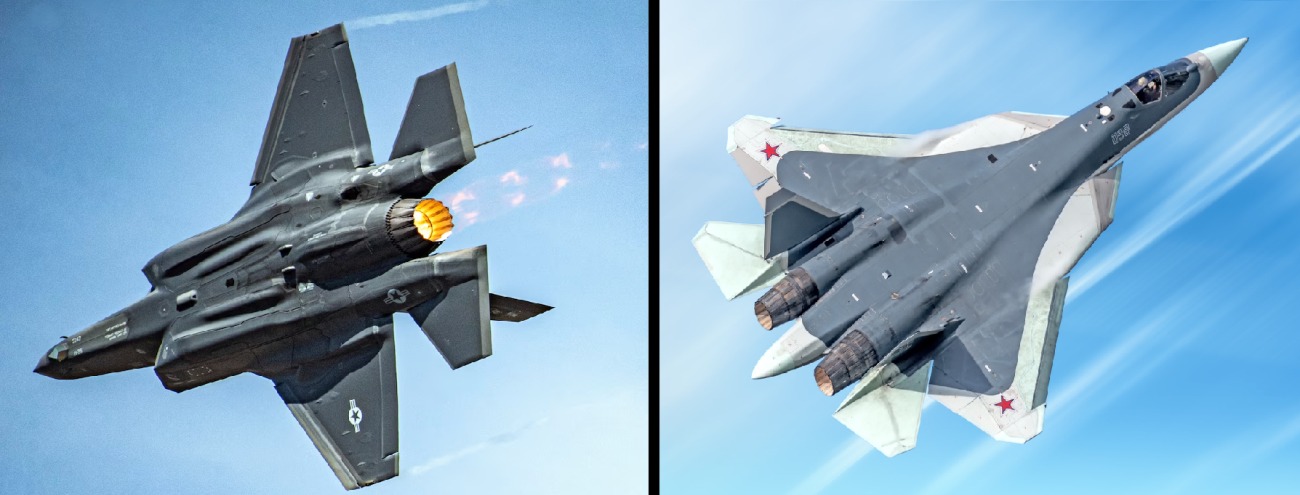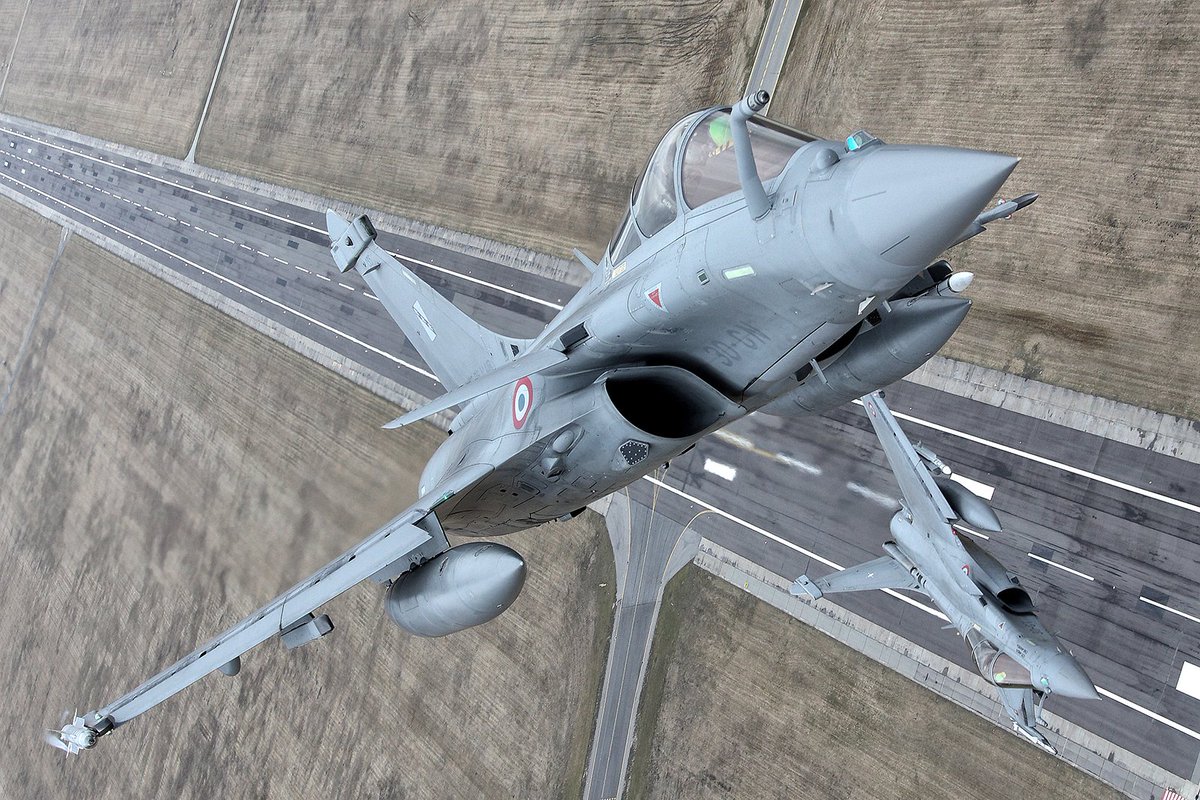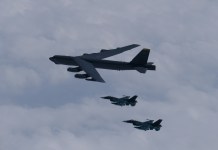Western defense analysts have been highlighting that the Russian fifth-generation Sukhoi Su-57 “Felon” fighter jet’s development and production have been delayed due to a number of factors, such as the Ukraine war and Western sanctions, which have restricted some critical micro-electronic components for major sensors and cockpit displays.
To compensate, Russia has been forced to ramp up production of the Su-30SM2 and Su-35S to make good numbers for the war effort.
Others feel there are only minor delays. In June 2019, the Russian Ministry of Defence signed a contract for the production of 76 Su-57s. As per the plan, three full Aviation Regiments of Su-57 fighters will be in existence by 2028.
Meanwhile, the Russian government has stated that the order numbers are going up, and the production rate for the Su-57 will double in 2024. The target is to deliver more than 20 Su-57s in 2024. If Su-57 production begins to increase, could it be of interest to India?
India-China Stand-Off Enters 5th Consecutive Winter; Indian Army Takes ‘Civilian Help’ To Hold Fort!
New Su-57 Batch Deliveries
The Su-57, Russia’s most advanced front-line aircraft, is produced at the Komsomolsk-on-Amur Aviation Plant in the Russian Far East. According to the Russian state-owned United Aircraft Corporation (UAC), a new batch of Su-57 fighter aircraft has been delivered and is already at their operational airbases.
The pilots and engineers are reportedly very happy with the aircraft’s performance.
Russia seems to have sorted out most technology development issues and supply chain bottlenecks. Meanwhile, the Sukhoi Design Bureau is continuously working on improving and expanding the aircraft’s functionality and building infrastructure for further expanding production.
Su-57 Woes, As Per Western Reports
The Russo-Ukraine War is in its third year. Russia has been unable to dominate Ukrainian airspace for various reasons, including inadequate Suppression of Enemy Air Defences (SEAD).
One other issue was the limited production of Russia’s fifth-generation stealth Su-57 fighters for penetration. It has been 14 years since its first flight in 2010, and less than 40 aircraft have been delivered. This is primarily due to design and development delays and the slow rate of production compounded by Western Sanctions. Actually, serious production didn’t even begin until 2019, reflecting the industrial bottlenecks that have hampered Russia’s war effort.
Western experts have estimated the aircraft’s Radar Cross-Section (RCS) at around 0.5 square meters, which is about the same as a typical 4th-generation aircraft and certainly phenomenally more than the F-35 class fighters.
The aircraft is still forced to fire weapons into Ukraine from its own territory. A real stealthy aircraft should have been able to intrude deeper without being seen.
Delays in the more advanced NPO Lyulka-Saturn AL-51 engines forced the designer to continue using the Al-41F1 engines, which are also used in the Su-35S. Western sanctions have affected the Su-57’s sensor suite. Based on deliveries to date, the West feels that the UAC is unlikely to meet the production target of 2024.
Su-57: A Very Capable Fighter
The West acknowledges that the Su-57 is a highly maneuverable fighter like most others from the Sukhoi fighter stable. Its 360-degree thrust vectoring allows aerodynamics-defying combat manoeuvres.
The Su-57’s ‘Integrated Modular Avionics Combat Systems’ uses fiber optic channels. It consists of the main nose-mounted N036-1-01 X band active electronically scanned array (AESA) radar with 1,514 T/R modules and two side-looking N036B-1-01 X-band AESA radars with 404 T/R modules embedded in the cheeks of the forward fuselage for increased angular coverage.

It also has an N036L-1-01 L-band array on the leading edges. Onboard computers process the X- and L-band signals, significantly enhancing the system’s information.
The aircraft’s electro-optical system includes infrared search and track (IRST), directional infrared countermeasures (DIRCM), ultraviolet missile approach warning sensors (MAWS), a thermal imager for low-altitude flight and landing, and a navigation and targeting pod.
The aircraft is capable of deploying countermeasures such as flares and radar decoys, as well as single-use programmable ECM transmitters. The Su-57 would also serve as a test-bed for advanced AI and man-unmanned teaming technologies.
Today, the Su-57 is one of the leading platforms, along with the Su-34 and Su-35, in Russia’s combat inventory and operations in Ukraine. Russia is also working on continuous integration of new weapons into the aircraft.
Several new air-to-surface weapon systems have evolved based on the combat experience in Ukraine. As part of the Manned-Unmanned Teaming (MUM-T), the Su-57 will be able to launch and/or control the S-71M “Monochrome” combat UAV for deep penetration attacks. Similar to the British Shadow Storm, the drone is more like an “air-to-surface” cruise missile.
Work is on to integrate the Okhotnik UCAV as a ‘loyal wingman’ for uncrewed teaming. A carrier-based variant of the aircraft is also under development. Reportedly, a ‘swarm’ teaming experiment had been conducted with a group of Su-35s and a Su-57 acting as a command and control aircraft.
The delay in upgrading the Su-57 with AL-51 engines is undeniable, but all production Su-57 fighters transferred to the VKS in 2024 would feature second-stage AL-51 engines.
The Stage 2 engines would feature serrated exhaust nozzles that improve thrust efficiency, stability, maneuverability, and performance while reducing engine Radar, IR, and noise signatures. The Stage 2 AL-51 will not only give the fighter super-cruise and longer range but also cut down operating costs because of better fuel consumption and longer engine life.
It is worth noting that the NPO Lyulka-Saturn AL-41F1 and AL-41F1S engines, which were developed from the AL-41F, simply did not fit into the Su-57 airframe. These smaller engines had had less thrust with 88.3 kN dry thrust, 142.2 kN in afterburner, and 147.1 kN in emergency power rating.
The AL-51F-1 has 107.9 kN dry thrust and 167 kN in afterburner. It is a two-shaft, low-bypass, after-burning turbofan engine. Unlike its AL-41F1 predecessor, the engine has glass-fiber plastic IGVs and convergent-divergent nozzles that use serrated flaps to reduce its signature. It also has a 19 percent higher thrust-to-weight ratio, 6.4 percent better specific thrust, and 9 percent lower specific fuel consumption.
The Russians have stated that the new engines allowed the plane to reach a maximum speed of 2,600 km/h and 2,100 km/h without using an afterburner.
Russia has also developed a variety of specific armaments that can be carried in internal weapon bays. The aircraft can carry four beyond-visual-range (BVR) missiles (R-37M) in its two main weapons bays and two short-range missiles (upgraded R-74) in the side bays.
It can carry bombs and surface-attack missiles on each station in the main bay. For missions that do not require stealth, the Su-57 can carry stores on its six external hardpoints, which could include the hypersonic Kh-47M2 Kinzhal air-launched ballistic missile.
The aircraft has seen operational action in Syria and Ukraine, albeit in limited missions. Whether the aircraft will be able to compete with the American F-22 and F-35 aircraft remains a matter of conjecture. The F-35 aircraft has a large number of financially powerful Western partners and also has huge orders from over 20 countries.
A Reasonably Priced & Low Life-Cycle Costs
The Su-57’s flyaway cost is reportedly around $35 million per aircraft. If true, it makes the Su-57 nearly half the price of the Chinese J-20 and even further cheaper than the much smaller single-engine F-35.
Russians suggest that the Su-57’s lifecycle costs are comparable to those of the Su-27, Su-30, and Su-35, which it was designed to replace. The Su-57 was intended to be the successor to the MiG-29 and Su-27. But it is clear that it will have to now operate in conjunction with the Su-35S and Su-30SM2.
Can India Acquire Su-57?
As India continues to slowly progress on its home-developed Advanced Medium Combat Aircraft (AMCA) fifth-generation fighter, Russia sees it as one of the few partnership or export options.
It has been making overtures. Russia also claims to be receiving requests from some (unnamed) foreign countries for the purchase of the Su-57 multi-role fighter. Until the production rates go up, the world has been at a wait-and-watch stage.
India had earlier joined the Sukhoi/HAL Fifth Generation Fighter Aircraft (FGFA) project, which evolved the Su-57. However, India withdrew from the FGFA program in 2018 for technical and operational reasons, as well as unequal cost and work-sharing issues.
India paid its 50 percent share of $250 million toward the initial development cost. Despite India’s exit, the two sides did leave a small window of hope for the future. With AMCA’s squadron entry timelines slipping past 2035, the speculation has begun.
India’s Urgency & Options For Fifth-Gen Aircraft
China has already produced 300 Chengdu J-20 “Mighty Dragon” fifth-generation fighters, and to match the US, it plans to induct 1,000 by 2035.
Pakistan has already announced its intention to have a fifth-generation fighter by 2029. They are talking to China for the smaller but fairly versatile Shenyang J-31.
Nearly 200 Pakistan Aeronautical Complex (PAC) complex technicians are currently working with Turkish Aerospace Industries (TAI) on the TAI TF Kaan fifth-generation aircraft project. They are likely to exercise one of the options.
The American Lockheed F-35 Lightning II aircraft is still not on offer, as India operates the Russian S-400 air defense system. While India pursues and accelerates the AMCA, the only global fifth-generation fighter option for New Delhi is the Russian Su-57.
But with 60 percent of the IAF still of Russian origin, is India ready to put more eggs in Russia’s basket? Also, with the never-ending war in Ukraine, likely extended sanctions, and dollar-payment restrictions, Russia’s ability to deliver will remain in question. India is thus stuck between the two ends of the Vice. But reviving the Indian connection with the Su-57 remains an option.
One school of thought is that the US could make an exception by selling a few F-35 squadrons to keep India away from Russia and in the American-led Western fold.

India is crucial for the US’ Indo-Pacific strategy. The technical hitches linked to the S-400 can be surmounted and secured through the already signed General Security of Military Information Agreement (GSOMIA) and Communications Compatibility and Security Agreement (COMCASA) agreements.
For the first time, the US brought the F-35 to Aero India in 2023. Over 1,000 F-35s are already flying in 17 air forces, and due to higher investments, they will continue to see upgrades at a much faster rate.
A Non-Stealthy Interim Option
The French Air and Space Force (FASF) has recently ordered 42 Rafale jets for around $5.5 billion. The purchase comes amidst French lawmakers’ concerns about the serious delays in Franco-German-Spanish “Future Combat Air System” (FCAS) project which was to be the successor of Rafale.
The FCAS is now predicted to enter full service no earlier than 2045 or 2050. The French defense procurement agency has notified Dassault Aviation and its major equipment suppliers, Thales, Safran, and MBDA, of the contract for the fifth round of Rafale production.
The Rafale is considered a 4.5-generation fighter. It has forward-hemisphere stealth and super-cruise capability. IAF Rafale aircraft are highly customized with some India-specific modifications. Essentially, they are of the F3-plus standard. The F3R standard was validated in 2018 and is currently in place on French Rafale.
Development of the F4 standard began in 2019. The standard improved onboard processing, external connectivity, MBDA’s MICA medium-range air-to-air missile, and upgrade of the Thales Spectra self-defense system.
The radar and sensor upgrades facilitate the detection of airborne stealth targets at long range. The helmet-mounted display also has improved capabilities.
With improved communications equipment, it is also more effective in network-centric warfare. Flight tests began in 2021, and the first F4-standard aircraft was delivered in 2023. All FASF aircraft are planned to be will be upgraded to this standard. UAE is the first foreign customer of F4.
The “Super Rafale” F5 standard will have cutting-edge capabilities. Dassault and its partners are already working on the standard, which will be ready by around 2030.
The F5 standard will have next-generation new sensors, armaments, and a faster and more secure ability to communicate and collaborate. The Rafale F5 will also act as a sensor truck with data fusion and processing abilities that allow it a tactical flying command post role, a role that is evolving in the USA’s Next Generation Air Dominance (NGAD).
The F5 will also be modified to carry the Anglo-French Future Cruise Missile (FCM) and Future Anti-Ship Missile (FASM). Thales RBE2 XG radar is planned for F5.
The “Super Rafale” will also be modified to carry hypersonic nuclear-guided missiles known as “ASN4G,” which will replace the nuclear-guided ASMPA missile as France’s deterrence capability.

It is planned to integrate a loyal unmanned wingman on the lines being evolved in the European nEUROn combat drone program. Most major countries, including India, are developing the loyal wingman concept.
The Rafale has seen action in Afghanistan, Libya, Mali, Iraq, and Syria. The number built to date is around 260. The new order will bring the total number of Rafale in the French armed forces to 234.
Rafale export orders currently stand at 297, including India (36), Egypt (55), Qatar (36), Greece (24), the United Arab Emirates (80), Indonesia (42), and Croatia (24) as current foreign customers. The FASF new order will keep Dassault Aviation Rafale’s production line active for the next 10 years.
If the IAF were to acquire 114 Rafale as a one-time import measure, all these could be made in India. India could choose to have the F5 variant, which will have many traits of the fifth-generation fighter.
To Summarize
The Indian Air Force (IAF) is considered the fourth largest and fourth most powerful air force. Its fighter squadrons are down to an all-time low of 31, and the IAF does not have a fifth-generation fighter.
Chinese J-20 numbers are growing rapidly, and the aircraft has been operating at airfields across the LAC (Line of Actual Control) in Xinjiang (Hotan) and Tibet (Shigatse).
While India must invest more and take a task force approach to developing the LCA Mk2 and AMCA, it needs an interim solution to make good numbers and reduce the capability gap with China. The choices are far and few. The time to exercise is now, lest we get left far behind.
- Air Marshal Anil Chopra (Retired) is an Indian Air Force veteran fighter test pilot and former Director-General of the Center for Air Power Studies in New Delhi. He has been decorated with gallantry and distinguished service medals while serving in the IAF for 40 years.
- He tweets @Chopsyturvey
- Follow EurAsian Times on Google News




